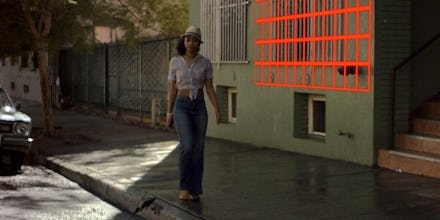Corporations Are Splicing Advertisements Into Your Favorite Music Videos

This week in utterly terrifying tech advancements, Rolling Stone reported on Tuesday that Universal Music Group has begun selling ad space in already-existing music videos.
The practice is called "retroactive product placement," and it's exactly what it sounds like: Companies work with Universal and a third-party ad agency, Mirriad, to splice images of products into videos on the company's Vevo channels.
The future is now, and it is awful. This sets a precedent where advertisers can make any piece of art suit their own purposes, regardless of its original intention.
The practice isn't new, though. Mirriad and companies like them have been splicing anachronisms into television reruns since at least 2011. They brand themselves as "advertising for the skip generation" — that's us — the logic being that if 18- to 34-year-olds won't watch cable TV ads and won't watch Web ads then, by golly, we'll put the ads right into their content. It's an idea so sinister, the company even got their own Colbert-skewering:
Mirriad's foray into music videos is more recent, though. It came in May, when they announced a deal with Vevo — partly owned by Universal — and spliced a Levi's billboard into Aloe Blacc's "The Man." They then released a press release that was, essentially, an advertisement for their advertisement.
Then came the Financial Times' report of the Universal deal, followed by a 30-day test run splicing Grand Marnier cognac into videos. The ads have been removed, but you can see before/after shots from Far East Movement, Darius Rucker, Avicii and Far East Movement (again) via Rolling Stone. As product placement goes, they're pretty blatant — but the technology proved good enough for even broader distribution.
Now, the test run is over. Universal's 500-plus artists and Vevo's 100,000-plus videos (good for 57.1 billion views in 2013) are open for business.
Those sheer numbers are likely enticing to advertisers, but what's more enticing is the malleability of it all. Rather than coordinating traditional product placement before filming, advertisers can plunk a bottle of booze in a 50 Cent video for 30 days, then plunk a different bottle of booze in a Blink-182 video, then plunk their special-edition bottle of booze in an LMFAO video. Companies can also localize ads, meaning fans in Germany might see a different bottle of booze than fans in Japan.
It's insidious for a number of reasons. But it's perhaps most destructive because viewers have no easy way of telling whether they're watching an original video. Take this 3-year-old video from Universal artist Jennifer Lopez. For a first-time viewer, there's no way to tell whether this ring box is real or doctored.
But don't worry — Mirriad COO Ted Mico says they're patrons of the arts; the artists do have a say in whether they participate, by the way.
"We're in the business of helping creatives make money out of the things they've already made," Mico told Rolling Stone. "Technology is allowing people to skip ads in all formats. If advertising starts to dry up, so does the content."
Because, of course, content is king. Except when it isn't.
Some people in the music industry are fighting back, though. Arcade Fire and St. Vincent's booking agent David Viecelli is quoted in Rolling Stone as comparing the practice to "blow[ing] guys in the bus station for chump change." Which kind of sounds like a lyric from this Arcade Fire song.
Regardless, retroactive advertising sets a precedent: That it's OK to go back and change a creation — made for art or otherwise — into an advertisement. Mirriad might not have crossed a line yet, but somebody eventually will. Maybe movie theaters will sign on. Maybe Netflix will sign on. Where will a line be drawn?
What's certainly hard to deny is that when bands and money get in bed together and things get rocky, the money usually has the upper hand. At the very least, the past should be protected.
h/t Rolling Stone